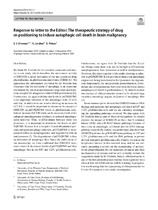| dc.contributor.author | Omoruyi, S.I | |
| dc.contributor.author | Jardine, A | |
| dc.contributor.author | Prince, S | |
| dc.date.accessioned | 2021-05-31T09:01:43Z | |
| dc.date.available | 2021-05-31T09:01:43Z | |
| dc.date.issued | 2021 | |
| dc.identifier.citation | Omoruyi, S.I. et al. (2021). Response to letter to the Editor: The therapeutic strategy of drug re-positioning to induce autophagic cell death in brain malignancy. Apoptosis, 26(1-2), pp. 2-3 | en_US |
| dc.identifier.issn | 13608185 | |
| dc.identifier.uri | 10.1007/s10495-020-01646-w | |
| dc.identifier.uri | http://hdl.handle.net/10566/6225 | |
| dc.description.abstract | We thank Dr Yoshida for his valuable comments and interest in our study which describes the anti-cancer activity
of DS00329, a novel derivative of the anti-psychotic drug
phenothiazine, in glioblastoma multiforme (GBM) [1]. We
appreciate the information provided by Dr Yoshida that
illustrates that the activation of autophagy is an important
mechanism by which neurochemical compounds and dopamine receptor D4 antagonists inhibit GBM proliferation [2].
Furthermore, we agree with him that levels of p62/SQSTM1
is an important indicator of the autophagic state of cells
and that, in addition to our results showing an increase in
LC3-11, it would be important to determine the impact of
DS00329 on p62/SQSTM1 levels in glioblastoma cells.
Indeed, increased LC3‐II levels can be associated with either
enhanced autophagosome synthesis or reduced autophagosome turnover. | en_US |
| dc.language.iso | en | en_US |
| dc.publisher | Springer Nature | en_US |
| dc.subject | Apoptosis | en_US |
| dc.subject | Autophagic cell death | en_US |
| dc.subject | Brain neoplasms | en_US |
| dc.subject | Glioblastoma | en_US |
| dc.subject | Humans | en_US |
| dc.title | Response to letter to the Editor: The therapeutic strategy of drug re-positioning to induce autophagic cell death in brain malignancy | en_US |
| dc.type | Article | en_US |

